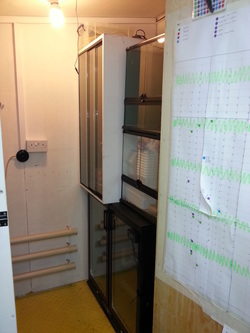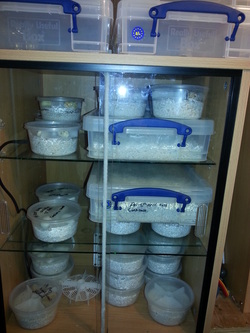Welcome to the Incubation Room.

This is my incubation room. It isn't totally finished yet but is is fully working and I have a few hundred Reptile eggs already cooking in here.
The room's internal dimensions are six foot by four foot by about seven feet high. It's constructed by a shed with 18mm shiplap board to the external with a 4 x 2 timber frame, between these 4 x 2 studs is 100mm Celotex foil backed insulation board with a internal skin of 12mm shuttering ply to the walls. The roof is constructed with 6 x 2 timbers with 150mm of Celotex foil backed insulation board with a 12mm ply skin to the ceiling internally. Finally the main floor is made from 25mm thick timber with 50mm of Celotex insulation on top then a false floor on top from 20mm tongue and grooved moisture resistant chipboard flooring lined with 5mm hard wearing anti-slip industrial flooring tiles.
To say this room is well insulated is an understatement, it takes just over an hour to drop 1 degree.
This room is heated by three, three foot tubular heaters totaling in 600 watts of power controlled by a Habistat Digital day night thermostat with built in timers. I have set the thermometer at 28 degrees centigrade during the day dropping to 24 degrees centigrade at night. It also controls the light in the room giving a daytime Photoperiod matching the same as outside. I havn't set the photoperiod for the sake of incubation, I have set the Photoperiod as I keep all of my young stock in here in my Brooders.
I strongly believe that giving reptiles a Photoperiod is a very vital part of husbandry as is the night time drop in temperature. all of my reptiles are given this and I also use it during Incubation.
In this photo you can see my converted display fridge at the bottom.
this has a two foot tubular heater that is controlled by another Habistat Digital Thermostat.
Above it to towards the back of the room is one of my Brooders.
The photo below shows you what is inside it. It is heated by a Habistat heat mat that covers the whole back panel of the brooder, this is controlled by a Habistat Dimming thermostat with Day/Night function.
The room's internal dimensions are six foot by four foot by about seven feet high. It's constructed by a shed with 18mm shiplap board to the external with a 4 x 2 timber frame, between these 4 x 2 studs is 100mm Celotex foil backed insulation board with a internal skin of 12mm shuttering ply to the walls. The roof is constructed with 6 x 2 timbers with 150mm of Celotex foil backed insulation board with a 12mm ply skin to the ceiling internally. Finally the main floor is made from 25mm thick timber with 50mm of Celotex insulation on top then a false floor on top from 20mm tongue and grooved moisture resistant chipboard flooring lined with 5mm hard wearing anti-slip industrial flooring tiles.
To say this room is well insulated is an understatement, it takes just over an hour to drop 1 degree.
This room is heated by three, three foot tubular heaters totaling in 600 watts of power controlled by a Habistat Digital day night thermostat with built in timers. I have set the thermometer at 28 degrees centigrade during the day dropping to 24 degrees centigrade at night. It also controls the light in the room giving a daytime Photoperiod matching the same as outside. I havn't set the photoperiod for the sake of incubation, I have set the Photoperiod as I keep all of my young stock in here in my Brooders.
I strongly believe that giving reptiles a Photoperiod is a very vital part of husbandry as is the night time drop in temperature. all of my reptiles are given this and I also use it during Incubation.
In this photo you can see my converted display fridge at the bottom.
this has a two foot tubular heater that is controlled by another Habistat Digital Thermostat.
Above it to towards the back of the room is one of my Brooders.
The photo below shows you what is inside it. It is heated by a Habistat heat mat that covers the whole back panel of the brooder, this is controlled by a Habistat Dimming thermostat with Day/Night function.
Inside the Brooder.

In the Brooder you can see some 4 litre RUBS (Really Useful Boxes)
I have drilled a number of holes in both ends to give ventilation to the residents.
Inside these RUBS are my Dumerilli boa (Acrantophis Dumerili) babies, these are all feeding well on defrosted rodents and will be ready to find new homes in the next month or so.
In the bug tubs are a early Corn snake hatchling and a early Leopard gecko hatchling. Behind them is my young Dasypeltis or African Egg eating snake who is pounding down fresh Quail, finch and Diamond Dove eggs.
Last but not least a bottle of water. This is at room temperature just in case I need to top up the Incubation substrate with water in one of my egg boxes, by having at optimum temperature I will not shock any eggs by drastically dropping the temperature, which is what would happen if I used cold water from the tap.
I have drilled a number of holes in both ends to give ventilation to the residents.
Inside these RUBS are my Dumerilli boa (Acrantophis Dumerili) babies, these are all feeding well on defrosted rodents and will be ready to find new homes in the next month or so.
In the bug tubs are a early Corn snake hatchling and a early Leopard gecko hatchling. Behind them is my young Dasypeltis or African Egg eating snake who is pounding down fresh Quail, finch and Diamond Dove eggs.
Last but not least a bottle of water. This is at room temperature just in case I need to top up the Incubation substrate with water in one of my egg boxes, by having at optimum temperature I will not shock any eggs by drastically dropping the temperature, which is what would happen if I used cold water from the tap.
In the Fridge-cubator.

There are only 14 Carpet Python (Irian Jaya x Jungle) eggs in here at the moment, but I have two other females that should drop soon, and a pair of female Blood Pythons that will hopefully drop soon. So all going well, it should fill up soon.
On the other Side.

At the moment most of this side is storage for my smaller RUBS, I use them for most of my hatchling Reptiles, however to the front center of the photo you will see one of my home made incubators. To the left of the photo you can see my year planner pinned to the inside of the incubation room door. Many people have different methods of logging times and dates of laying and expected hatching, but I find the easiest way for me, is to have it all on display on one chart.
Back to the right of the photo you can see the control panel for the Habistat Digital Thermostat that controls the rooms temperature and lights.
You can also see the three tubular heaters on the back wall that heat the room.
Back to the right of the photo you can see the control panel for the Habistat Digital Thermostat that controls the rooms temperature and lights.
You can also see the three tubular heaters on the back wall that heat the room.
In my little Homemade Incubator.

This little incubator is now really full and I have babies hatching daily, but when this Photo was taken, it was only half full.
The two RUBS are 4ltr in size and have many Corn snake eggs in them, the photo at the top of the page gives you some idea of how many in each. And just to add to that my Corn snake Girlies are going down for their second clutch, so many more eggs on the way.
I have now added a couple more, and filled the smaller gaps with the Deli tub egg boxes.
I also have many Leopard gecko and Bearded Dragon eggs in here now, so its looking like its going to be a busy season.
I'm going to add another page, keeping you updated on what eggs are going in and what is hatching. Here
The two RUBS are 4ltr in size and have many Corn snake eggs in them, the photo at the top of the page gives you some idea of how many in each. And just to add to that my Corn snake Girlies are going down for their second clutch, so many more eggs on the way.
I have now added a couple more, and filled the smaller gaps with the Deli tub egg boxes.
I also have many Leopard gecko and Bearded Dragon eggs in here now, so its looking like its going to be a busy season.
I'm going to add another page, keeping you updated on what eggs are going in and what is hatching. Here